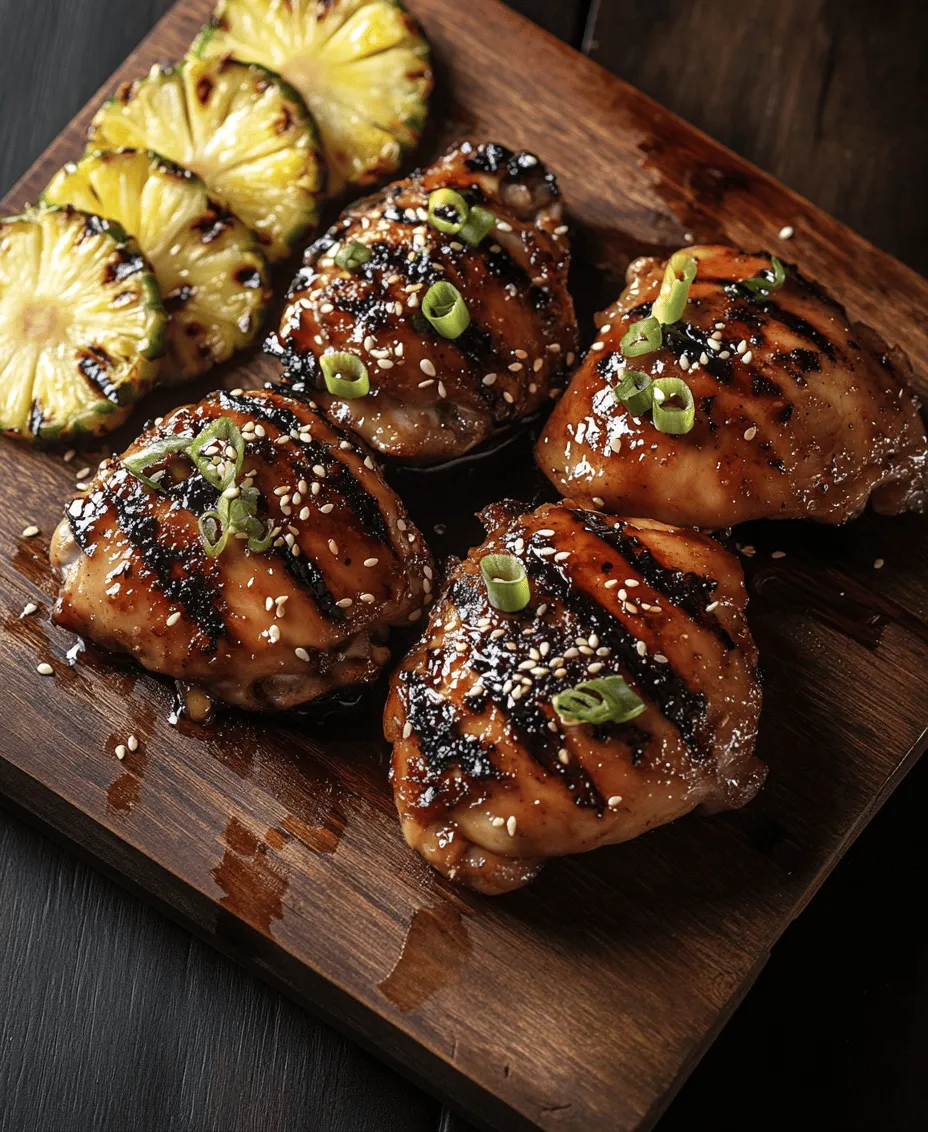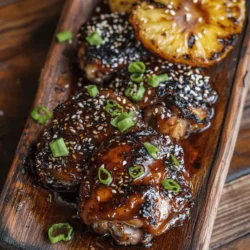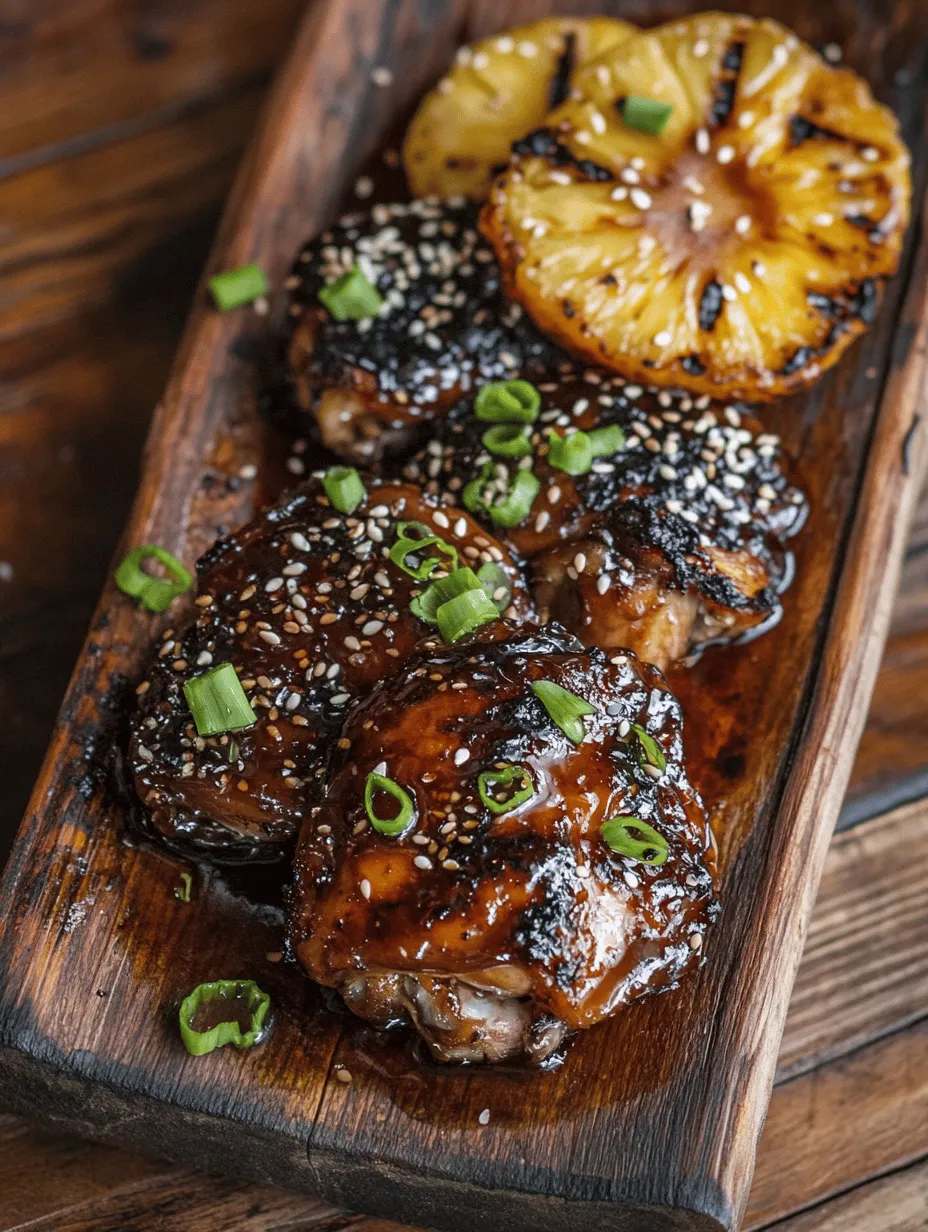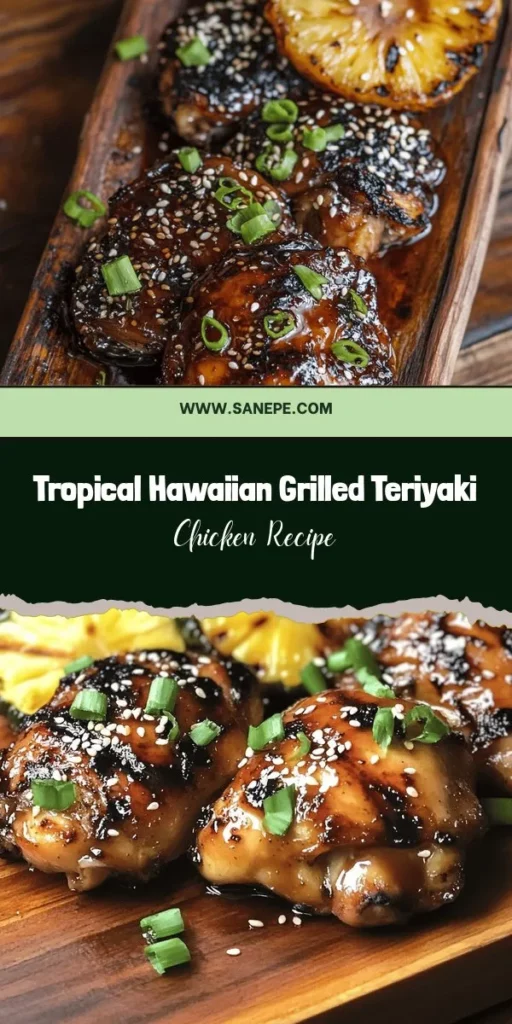Introduction
Hawaiian cuisine is a vibrant tapestry woven from the rich cultural influences of Polynesian, Asian, and American flavors. This unique culinary tradition celebrates fresh, tropical ingredients, bringing together the sweetness of fruits and the savory notes of grilled meats. One dish that epitomizes this flavor fusion is Hawaiian Grilled Teriyaki Chicken. This recipe not only showcases the essence of Hawaii but also provides a deliciously satisfying meal that is perfect for summer barbecues or cozy family dinners.
At the heart of Hawaiian Grilled Teriyaki Chicken lies the teriyaki sauce, a sweet and savory glaze that elevates the chicken to new culinary heights. The key to achieving a mouth-watering teriyaki chicken lies in the quality of ingredients and the marinating process. Using fresh, high-quality components not only enhances the flavor but also ensures that each bite bursts with the authentic taste of Hawaii. Marinating the chicken allows the flavors to penetrate deeply, resulting in a tender, juicy dish that is sure to impress. In this article, we will delve into the intricate details of this recipe, exploring the origins of teriyaki sauce, the essential ingredients, and the marination process that makes this dish a true delight.
Understanding Teriyaki Sauce
To truly appreciate Hawaiian Grilled Teriyaki Chicken, we must first understand the teriyaki sauce that gives it its distinctive flavor. The term “teriyaki” translates to “glaze broiled” in Japanese, and its history dates back to the early 17th century. It is believed that teriyaki originated in Japan, where it was used to prepare grilled meats and fish. Over time, the sauce evolved, incorporating various regional ingredients to create the sweet and savory blend we know today.
Traditional teriyaki sauce is made from a few key components: soy sauce, mirin or sake, sugar, and sometimes ginger and garlic. Soy sauce serves as the base, providing a salty and umami flavor, while mirin or sake adds sweetness and depth. Sugar, typically in the form of brown sugar, caramelizes as it cooks, giving the sauce its signature glaze. Variations of teriyaki sauce exist, with some recipes incorporating additional ingredients like pineapple juice, sesame oil, or even fruit purees to enhance the flavor. Each variation offers a unique twist, allowing for a wide range of taste experiences.
When preparing Hawaiian Grilled Teriyaki Chicken, the teriyaki sauce plays a crucial role in the overall flavor profile. The addition of pineapple juice not only complements the sweetness of the marinade but also reflects the tropical essence of Hawaiian cuisine. This fusion of flavors creates a savory dish that is both satisfying and refreshing.
Ingredients Breakdown
To create an authentic Hawaiian Grilled Teriyaki Chicken, it is essential to source the right ingredients. Here’s a detailed breakdown of each component used in this recipe:
1. Boneless, Skinless Chicken Thighs: Chicken thighs are favored in this recipe for their rich flavor and tender texture. Unlike chicken breasts, thighs have a higher fat content, which helps keep the meat moist during grilling. Additionally, the dark meat absorbs marinades better, enhancing the overall taste of the dish.
2. Soy Sauce: The foundation of teriyaki sauce, soy sauce comes in various types, including light, dark, and low-sodium options. Light soy sauce is saltier and is often used for marinades, while dark soy sauce adds a deeper color and a slightly sweeter taste. For Hawaiian Grilled Teriyaki Chicken, a combination of light and dark soy sauce can be used for a balanced flavor.
3. Brown Sugar vs. White Sugar: While both sugars can be used in marinades, brown sugar is preferred for its rich molasses flavor. This adds a depth of sweetness that complements the savory elements of the soy sauce. White sugar can also be used, but it lacks the complexity that brown sugar provides.
4. Honey: Honey is often included in teriyaki marinades for its natural sweetness and thick texture. It not only adds flavor but helps create a sticky glaze when grilled, enhancing the overall presentation of the dish.
5. Garlic and Ginger: These aromatic ingredients are crucial for adding depth to the marinade. Fresh garlic provides a pungent kick, while ginger adds warmth and a hint of spice. Together, they create a well-rounded flavor that elevates the chicken.
6. Sesame Oil: This oil is rich and nutty and contributes to the overall flavor profile of the teriyaki sauce. A small amount goes a long way in enhancing the dish, making sesame oil an essential ingredient in this recipe.
7. Black Pepper: Freshly ground black pepper adds a subtle heat that balances the sweetness of the marinade. It’s important to use freshly cracked pepper for the best flavor.
8. Pineapple Juice: This ingredient is what truly sets Hawaiian Grilled Teriyaki Chicken apart from other teriyaki recipes. The acidity of pineapple juice tenderizes the chicken while adding a tropical sweetness that is unmistakably Hawaiian.
9. Optional Ingredients for Thickening: Some cooks prefer to thicken their teriyaki sauce for a richer glaze. Options include cornstarch mixed with water or a reduction of the sauce over heat until it reaches the desired consistency.
Marination Process
The marination process is a critical step in preparing Hawaiian Grilled Teriyaki Chicken, as it allows the flavors to meld together and penetrate the meat. Marinating chicken not only enhances the taste but also helps to tenderize the meat, resulting in a juicier final product. Here’s how to achieve optimal marination for this recipe:
1. Preparation of Marinade: Begin by combining all the marinade ingredients in a bowl or a resealable plastic bag. Whisk together until well combined, ensuring that the sugar is dissolved and the flavors are evenly distributed.
2. Marinating the Chicken: Place the boneless, skinless chicken thighs in the marinade, ensuring that each piece is fully submerged. If using a bowl, cover it with plastic wrap; if using a bag, seal it tightly, removing as much air as possible. This allows for even marination coverage.
3. Recommended Marinating Times: For best results, marinate the chicken for at least 30 minutes, but ideally, aim for 2 to 4 hours. If you have the time, marinating overnight in the refrigerator will yield even deeper flavors. However, avoid marinating for more than 24 hours, as the chicken may become overly tender and mushy due to the acidic pineapple juice.
4. Tips for Even Marination Coverage: To ensure even coverage, turn the chicken pieces occasionally during the marinating period. This allows all sides to absorb the flavors equally. Consider using a vacuum seal bag to minimize air exposure, which can contribute to a more effective marination process.
With the marinade ready and the chicken infused with flavor, you are now prepared to take the next steps in creating a delicious Hawaiian Grilled Teriyaki Chicken that captures the essence of the tropics. Stay tuned for the detailed instructions on grilling and finishing this delightful dish.

Grilling Techniques
Grilling Hawaiian Grilled Teriyaki Chicken requires both skill and technique to achieve that perfect balance of flavor and juiciness. Below are key steps to ensure your chicken turns out mouth-wateringly delicious.
Preparing the Grill: Temperature Control and Methods
Before you start grilling, it’s essential to prepare your grill correctly. Whether you are using a gas or charcoal grill, preheating is crucial. For gas grills, turn on all burners and set the temperature to medium-high (approximately 375°F to 450°F). For charcoal grills, allow the coals to burn until they’re covered with white ash, which indicates they’re at the right temperature.
Maintaining consistent heat is vital. If you notice hot spots on your grill, you can move the chicken around to avoid overcooking any area. Using a grill thermometer can help you monitor the temperature accurately, ensuring even cooking throughout.
Importance of Preheating for Even Cooking
Preheating your grill is not only beneficial for achieving those sought-after grill marks; it also helps in cooking the chicken evenly. If the grill is not hot enough when you place the chicken on it, the meat may stick to the grates, leading to tearing and uneven cooking. Preheating allows the chicken to sear quickly, locking in juices and flavors.
How to Properly Grill Chicken for Optimal Juiciness and Flavor
Once your grill is preheated, it’s time to grill the chicken. Remove the marinated chicken from the refrigerator, allowing it to come to room temperature for about 15 minutes. This helps in cooking the chicken evenly and prevents the outside from overcooking before the inside is done.
Place the chicken on the grill and close the lid. Avoid lifting the lid too often; this can cause the temperature to drop, affecting the cooking process. Grill the chicken for about 6-7 minutes on one side, then flip it over. The chicken is done when it reaches an internal temperature of 165°F. Use a meat thermometer for precise measurement to avoid undercooking or overcooking.
Techniques for Achieving Perfect Grill Marks
To achieve those coveted grill marks, ensure the chicken is placed diagonally across the grill grates. Leave it undisturbed for the first few minutes to allow the chicken to sear. After about 3-4 minutes, you can rotate the chicken 90 degrees to create a crosshatch pattern. This technique enhances both the appearance and taste of your teriyaki chicken.
Creating the Teriyaki Glaze
The teriyaki glaze is what elevates this dish and ties all the flavors together. Here’s how to create a rich, flavorful glaze for your grilled chicken.
Step-by-Step Guide on Thickening the Reserved Marinade
After marinating the chicken, you’ll have some marinade left over. To transform this into a glaze, begin by pouring the reserved marinade into a saucepan. Simmer it over medium heat, allowing it to reduce. This process will concentrate the flavors and thicken the mixture.
Bring the marinade to a gentle boil, then reduce the heat to low and simmer for 10-15 minutes, stirring occasionally. If you want a thicker consistency, mix a tablespoon of cornstarch with two tablespoons of water to create a slurry. Gradually add this to your simmering marinade, stirring continuously until the glaze thickens to your desired consistency.
Importance of Cooking the Marinade Thoroughly to Ensure Safety
It’s essential to bring the marinade to a boil and cook it thoroughly before using it as a glaze. This step ensures that any bacteria from the raw chicken are eliminated, making it safe to eat. Never use raw marinade that has come in contact with the uncooked chicken without cooking it first.
Tips for Balancing Flavors in the Glaze
When thickening your teriyaki marinade, taste it periodically to achieve the perfect balance of sweet, salty, and savory flavors. You can adjust the sweetness by adding more honey or brown sugar, while soy sauce adds depth and saltiness. If you prefer a spicy kick, consider incorporating a dash of red pepper flakes or sriracha into the glaze.
Grilling Fresh Pineapple
Grilling pineapple alongside your teriyaki chicken not only enhances the meal but also adds a delightful burst of flavor.
Benefits of Grilling Pineapple as a Side
Grilling pineapple caramelizes its natural sugars, resulting in a sweet, smoky, and juicy side that perfectly complements the savory flavors of teriyaki chicken. The slight char adds depth, making it a standout side dish for any BBQ.
Techniques for Achieving the Perfect Char on Pineapple
To grill pineapple, start with fresh, ripe fruit. Cut the pineapple into thick rings or wedges, ensuring they are uniform in size for even cooking. Preheat your grill to medium heat and lightly oil the grates to prevent sticking.
Place the pineapple on the grill and cook for about 3-4 minutes on each side. You’ll know it’s ready when you see beautiful grill marks and the flesh becomes tender. For added flavor, consider brushing the pineapple with a hint of leftover teriyaki glaze while grilling.
Flavor Pairing of Grilled Pineapple with Teriyaki Chicken
The sweet and tangy flavor of grilled pineapple complements the savory umami notes of teriyaki chicken beautifully. Together, they create a harmonious balance of flavors, making each bite a delightful experience. Serve the grilled pineapple alongside the chicken for an aesthetically pleasing and delicious plate.
Serving Suggestions
Presentation plays a significant role in the dining experience. Here are some ideas to elevate your Hawaiian Grilled Teriyaki Chicken dish.
Presentation Ideas for an Appealing Dish
To create an inviting presentation, start by placing the grilled teriyaki chicken on a large serving platter. Arrange the grilled pineapple around the chicken, and consider adding a sprinkle of sesame seeds and chopped green onions for a burst of color and flavor.
For an island-inspired touch, place a few fresh cilantro or parsley sprigs on the platter. You can also serve the dish with lime wedges for an extra citrusy zing.
Suggested Sides to Complement the Hawaiian Grilled Teriyaki Chicken
In addition to grilled pineapple, several sides pair excellently with your teriyaki chicken. Consider serving:
– Coconut Rice: The creaminess of coconut rice provides a lovely contrast to the savory chicken.
– Grilled Vegetables: Bell peppers, zucchini, and red onions add colorful and nutritious elements to the meal.
– Asian Slaw: A crunchy slaw made with cabbage, carrots, and a light dressing can refresh the palate between bites of chicken.
Importance of Garnishing with Sesame Seeds and Green Onions
Finishing your dish with sesame seeds and green onions not only enhances the visual appeal but also adds texture and flavor. The nutty crunch of sesame seeds and the fresh bite of green onions elevate the overall dining experience, making your Hawaiian Grilled Teriyaki Chicken even more delightful.
Nutritional Information
When preparing Hawaiian Grilled Teriyaki Chicken, it’s essential to consider the nutritional aspects of the main ingredients.
Overview of the Nutritional Benefits of the Main Ingredients
– Chicken: A lean source of protein, chicken is low in fat, especially when using skinless breasts. It provides essential amino acids necessary for muscle growth and repair.
– Pineapple: Rich in vitamins C and B6, manganese, and dietary fiber, grilled pineapple contributes to overall health. Its natural sugars provide a sweet flavor without added calories.
– Soy Sauce: While it does contain sodium, using low-sodium soy sauce can help manage salt intake while still imparting that characteristic umami flavor.
– Honey: A natural sweetener, honey offers antioxidants and can enhance the immune system.
Discussion on Portion Control and Healthy Eating
To maintain a balanced diet, consider portion control when serving the chicken and sides. Aim for a palm-sized portion of chicken, accompanied by a generous serving of grilled vegetables and a small serving of rice or slaw. This ensures you enjoy the flavors of the dish while maintaining overall health.
Conclusion
Hawaiian Grilled Teriyaki Chicken is more than just a meal; it’s an experience that brings the vibrant flavors of the islands to your kitchen. The combination of sweet and savory elements, paired with the smoky char of the grill, creates a dish that is both satisfying and memorable.
By following the steps outlined, you can create a beautiful, delicious dinner that transports you to the beaches of Hawaii with every bite. Whether you’re hosting a summer BBQ or enjoying a cozy night in, this recipe is sure to impress friends and family alike.
We encourage you to try this recipe for a taste of the islands at home. Embrace the joy of grilling and the satisfaction of enjoying homemade meals that bring warmth and flavor to your table. So fire up that grill and savor the delightful combination of Hawaiian Grilled Teriyaki Chicken with grilled pineapple. This dish is more than just food; it’s a celebration of flavor, culture, and the joy of cooking.


